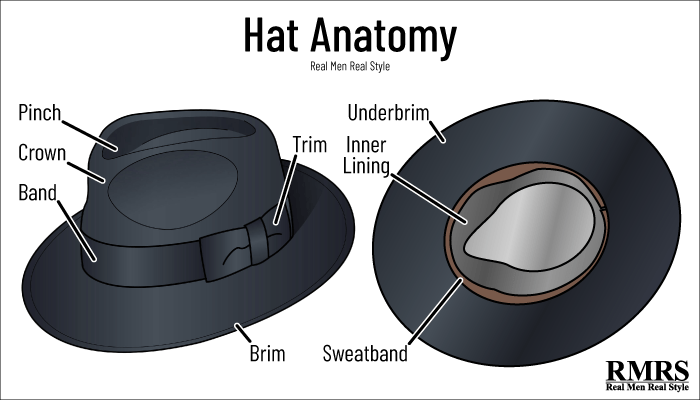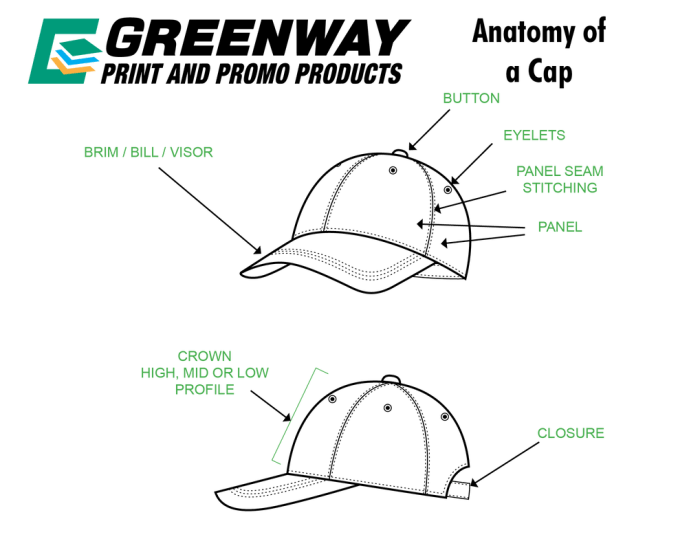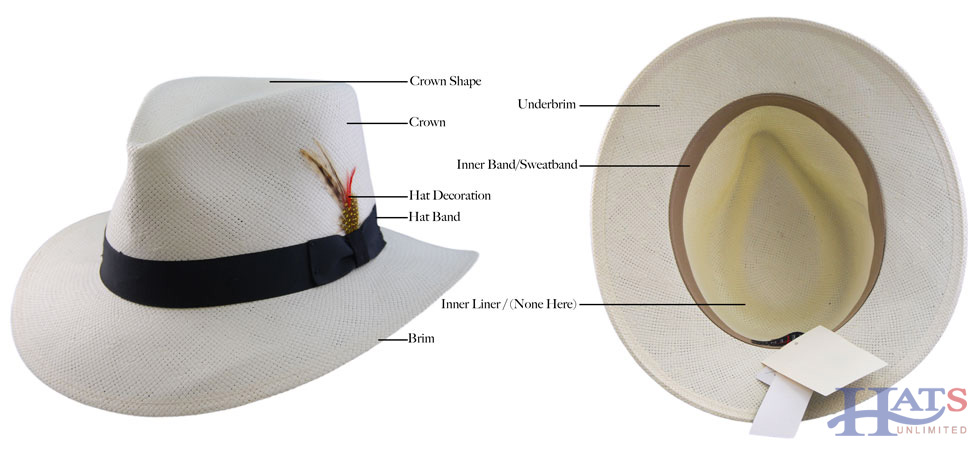Dive into the fascinating world of millinery with our comprehensive parts of a hat diagram. From the brim to the crown, we’ll unravel the intricate details and functions of each element, providing a clear understanding of hat construction and design.
Whether you’re a hat enthusiast, a fashion designer, or simply curious about the inner workings of headwear, this guide will equip you with the knowledge to navigate the diverse landscape of hats.
Overview of a Hat

Hats are a type of head covering that is worn for various purposes, including protection from the elements, fashion, and religious or cultural reasons. They come in a wide range of styles, materials, and designs, each with its own unique purpose and appeal.
Hats can be broadly categorized into two main types: functional and non-functional. Functional hats are designed to serve a specific purpose, such as providing protection from the sun, rain, or cold. Non-functional hats, on the other hand, are primarily worn for fashion or as a cultural or religious symbol.
Understanding the parts of a hat diagram can be a breeze, especially when you know how to use the SUM function in Excel. Just like the crown of a hat protects your head, the SUM function can quickly add up all the numbers in a range of cells.
Check out our guide How To Sum In Excel for a step-by-step tutorial. With this newfound knowledge, you’ll be able to navigate the parts of a hat diagram with confidence, knowing that you can easily calculate the brim’s width or the height of the crown.
Types of Hats
There are numerous types of hats, each with its own distinct style and purpose. Some of the most common types include:
- Baseball caps: These are casual, visor-brimmed hats that are often worn for sports or outdoor activities.
- Beanies: These are close-fitting, knitted hats that are designed to provide warmth in cold weather.
- Berets: These are round, flat-crowned hats that are typically made of wool or felt.
- Cowboy hats: These are wide-brimmed hats that are traditionally worn by cowboys and cowgirls.
- Fedora hats: These are soft, wide-brimmed hats that are often associated with jazz musicians and gangsters.
- Panama hats: These are lightweight, straw hats that are originally from Ecuador.
- Sun hats: These are wide-brimmed hats that are designed to protect the wearer from the sun’s rays.
- Top hats: These are tall, cylindrical hats that are often worn for formal occasions.
Major Components of a Hat: Parts Of A Hat Diagram

A hat is a garment worn on the head, typically to provide protection from the elements or for fashion. Hats come in a wide variety of styles, but all share some basic components.
The primary parts of a hat include the crown, brim, and sweatband. The crown is the top part of the hat that covers the head. The brim is the outer edge of the hat that extends out from the crown.
The sweatband is a band of material that fits inside the hat and helps to absorb sweat.
Diagram of a Hat
The following diagram shows the major components of a hat:
[Insert diagram here]
Table of Hat Components
The following table provides a summary of the major components of a hat, along with their descriptions and functions:
| Part | Description | Function |
|---|---|---|
| Crown | The top part of the hat that covers the head | Protects the head from the elements and provides warmth |
| Brim | The outer edge of the hat that extends out from the crown | Protects the face and neck from the sun and rain |
| Sweatband | A band of material that fits inside the hat and helps to absorb sweat | Keeps the hat from becoming uncomfortable to wear |
Specific Parts of a Hat

Beyond the general overview, let’s delve into the specific components that make up a hat, focusing on their shapes, sizes, and materials.
Brim, Parts of a hat diagram
The brim is the outward-extending part of a hat that surrounds the crown. It can vary greatly in shape and size, from the wide, floppy brims of sun hats to the narrow, upturned brims of fedoras. Brims can be made from various materials, including straw, felt, fabric, or leather.
Crown
The crown is the central part of a hat that sits atop the head. It can vary in height, shape, and construction. Common crown shapes include the rounded dome of a baseball cap, the pinched teardrop of a fedora, or the flat-topped cylinder of a bowler hat.
Crown construction can involve a single piece of material or multiple panels sewn together.
Band or Sweatband
The band or sweatband is a narrow strip of material that lines the inside of the hat’s crown. Its primary purpose is to absorb sweat and prevent it from dripping down the wearer’s face. Sweatbands can be made from various materials, including cotton, leather, or synthetic fabrics.
Additional Features and Accessories

Apart from the main components of a hat, there are additional features and accessories that can enhance its style, functionality, and significance. These embellishments can range from practical elements to purely decorative ones, each serving a specific purpose or conveying a particular meaning.
Some common hat accessories include:
Feathers
- Feathers are often used as decorative accents on hats, adding a touch of elegance or whimsy.
- In some cultures, feathers have symbolic meanings, representing power, status, or religious significance.
Buckles
- Buckles are functional accessories that help secure hats on the wearer’s head, especially in windy conditions.
- They can also add a touch of style to the hat, coming in various designs and materials.
Ornaments
- Ornaments encompass a wide range of decorative elements, such as beads, sequins, ribbons, and appliques.
- These ornaments can personalize hats, making them unique and reflective of the wearer’s taste.
Hat Construction and Materials

The construction and materials used in hat making significantly impact the durability, style, and comfort of a hat. Understanding these aspects can help you make informed choices when selecting a hat.
Materials Commonly Used in Hat Making
- Natural fibers:Straw, cotton, linen, and wool are breathable, comfortable, and offer natural UV protection.
- Synthetic fibers:Polyester, nylon, and acrylic are durable, moisture-resistant, and often more affordable than natural fibers.
- Animal fibers:Fur, leather, and suede provide warmth, durability, and a luxurious look.
- Other materials:Plastic, paper, and even recycled materials are used for unique and innovative hat designs.
Construction Methods for Hats
Hats are constructed using various methods, each with its own advantages and disadvantages:
- Sewn construction:Fabric or leather pieces are sewn together to create the hat’s shape.
- Blocked construction:A mold or block is used to shape and stretch the hat material.
- Knitted or crocheted construction:Yarn is looped or hooked together to create the hat’s fabric.
- Woven construction:Fibers are interlaced to create a sturdy and flexible hat.
Impact of Materials and Construction on Hat Durability and Style
The choice of materials and construction methods directly influences the durability and style of a hat:
- Durability:Natural fibers and synthetic fibers offer different levels of durability, with synthetic fibers being more resistant to wear and tear.
- Style:The material and construction method can create different visual effects, from elegant and formal to casual and sporty.
Question & Answer Hub
What is the purpose of a hat brim?
The brim protects the face and neck from the sun, rain, or other elements.
What is the difference between a crown and a band?
The crown is the top part of the hat that covers the head, while the band is the strip of material that goes around the base of the crown and helps to keep the hat in place.
What materials are commonly used to make hats?
Hats can be made from a variety of materials, including straw, felt, leather, fabric, and plastic.